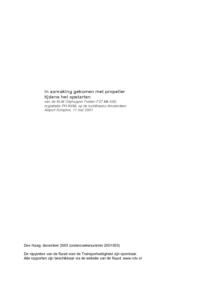
This information is added by users of ASN. Neither ASN nor the Flight Safety Foundation are responsible for the completeness or correctness of this information.
If you feel this information is incomplete or incorrect, you can submit corrected information.
| Date: | Friday 11 May 2001 |
| Time: | |
| Type: |  Fokker 50 |
| Owner/operator: | KLM Cityhopper |
| Registration: | PH-KXM |
| MSN: | 20252 |
| Year of manufacture: | 1992 |
| Fatalities: | Fatalities: 0 / Occupants: 30 |
| Aircraft damage: | None |
| Category: | Accident |
| Location: | Amsterdam-Schiphol International Airport (AMS/EHAM) -
 Netherlands Netherlands
|
| Phase: | Standing |
| Nature: | Passenger - Scheduled |
| Departure airport: | Amsterdam-Schiphol International Airport (AMS/EHAM) |
| Malmö | |
| Investigating agency: | Dutch Safety Board |
| Confidence Rating: |
On 11 May 2001, the cockpit and cabin crew of KL1173 made all the necessary preparations for their flight from Amsterdam to Malmö. At the scheduled departure time, the crew was informed by Air Traffic Control of a short delay to their start-up. Also at this time a mechanic from Martinair (the contracted maintenance organisation for KLM Cityhopper) plugged his headset into the external service/interphone panel located on the right side of the fuselage, below the first officer’s cockpit sliding window. The mechanic remained in this position during the start delay period. When the start-up of both engines was completed, external power was removed from the aircraft and the first flight of the day before taxi scan was commenced. During this scan the first officer who was pilot flying activated the aircraft de-icing boots. The captain and first officer both visually checked the proper inflation of the de-icing boots on their respective wings and the first officer asked the mechanic to look at the tail section. A short time later a strange noise was heard apparently from the engines. At the same time the ground crew who was assisting with the external power, ran around the front of the aircraft nose and signalled frantically to the duty officer who was sitting in a vehicle parked near the aircraft nose on the captain’s side. The duty officer came out of his vehicle, looked under the aircraft, and immediately gave a hand signal to the captain to cut the engines. The mechanic had walked through the edge of the right propeller and had sustained serious injuries.
Causes
The following causal factors were identified:
• The mechanic had to perform a task for which he was not properly trained.
• The GWK allowed the mechanic to dispatch the aircraft on his own.
• The mechanic reacted on impulse to proceed to the aircraft tail.
• Due to the light conditions the mechanic did not see the propeller.
Contributing factors were:
• Neither KLC nor MME defined specific instructions for executing the visual de-icing boots check.
• There was insufficient consideration by KLC and MME organisations of the risks involved prior to the introduction of the de-icing boots check.
• There was no formal system in place for the GWK to correctly assess the capability of the mechanic.
• The mechanic did not have any line experience with propeller aircraft.
• There were no visual warnings marking the danger areas of the propeller.
• The APU was not allowed to be used to check the de-icing boots inflation system prior to engine start.
• The light conditions may have made it difficult to see the tail section of the aircraft.
The underlying causes were:
• The absence of a hazard inventory and –evaluation of the functions of departure service personnel as integral part of the company safety management system.
• Insufficient supervision on the enforcement of the Occupational Safety and Health Act
Accident investigation:
 |
|
Sources:
Dutch Safety Board
Revision history:
| Date/time | Contributor | Updates |
|---|---|---|
| 25-Sep-2020 15:40 | ASN Update Bot | Added |
| 13-Jun-2022 04:48 | Ron Averes | Updated [Location] |
Corrections or additions? ... Edit this accident description
The Aviation Safety Network is an exclusive service provided by:


 ©2024 Flight Safety Foundation
©2024 Flight Safety Foundation